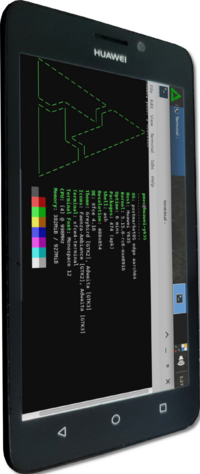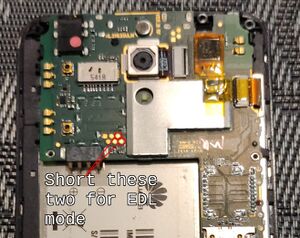Huawei Y635 (huawei-y635)
Appearance
| This page is about the dedicated port of this device. There is also an optional generic port available for this device - see Generic MSM8916 (qcom-msm8916). |
 Huawei Y635 on mainline with Xfce | |
| Manufacturer | Huawei |
|---|---|
| Name | Y635 |
| Codename | huawei-y635 |
| Released | 2015 |
| Type | handset |
| Hardware | |
| Chipset | Qualcomm Snapdragon 410 (MSM8916) |
| CPU | Quad-core 1.2 GHz Cortex-A53 |
| GPU | Adreno 306 |
| Display | 480 x 854 (IPS LCD, 5.0") |
| Storage | 4/8 GB |
| Memory | 1 GB |
| Architecture | aarch64 |
| Software | |
Original software The software and version the device was shipped with. |
Android 4.4.4 (EMUI 3) |
Extended version The most recent supported version from the manufacturer. |
Android |
| FOSS bootloader | yes |
| postmarketOS | |
| Category | testing |
Mainline Instead of a Linux kernel fork, it is possible to run (Close to) Mainline. |
yes |
Unixbench score Unixbench Whetstone/Dhrystone score. See Unixbench. |
915.7 |
| Optional Generic Port | Generic MSM8916 (qcom-msm8916) |
| Device package |
|
| Kernel package |
|
Flashing Whether it is possible to flash the device with pmbootstrap flasher. |
Works
|
|---|---|
USB Networking After connecting the device with USB to your PC, you can connect to it via telnet (initramfs) or SSH (booted system). |
Works
|
Battery Whether charging and battery level reporting work. |
Works
|
Screen Whether the display works; ideally with sleep mode and brightness control. |
Works
|
Touchscreen |
Works
|
| Multimedia | |
3D Acceleration |
Works
|
Audio Audio playback, microphone, headset and buttons. |
Works
|
Camera |
Broken
|
| Connectivity | |
WiFi |
Works
|
Bluetooth |
Works
|
GPS |
Broken
|
| Modem | |
Calls |
Broken
|
SMS |
Broken
|
Mobile data |
Broken
|
| Miscellaneous | |
FDE Full disk encryption and unlocking with unl0kr. |
Works
|
USB OTG USB On-The-Go or USB-C Role switching. |
Broken
|
| Sensors | |
Accelerometer Handles automatic screen rotation in many interfaces. |
Works
|
Ambient Light Measures the light level; used for automatic screen dimming in many interfaces. |
Works
|
Proximity |
Works
|
| This device is based on the Snapdragon 410. See the SoC page for common tips, guides and troubleshooting steps |
Contributors
Maintainer(s)
Users owning this device
- Ungeskriptet (Notes: Secure boot off; First device I ever mainlined)
How to enter flash mode
- Fastboot: Power on the device with both and buttons while connected to a PC with a USB cable.
- Recovery: Power on the device with both and buttons.
- lk2nd Fastboot: Power on the device. After it vibrates, hold .
- lk2nd Recovery: Power on the device. After it vibrates, hold .
EDL mode
To enter the EDL mode, these two points must be shorted while powering it on. If lsusb -d 05c6:9008 shows you a device, you can let go of the short.
Preparation
Follow the preparation guide for the Huawei Ascend G7 until the Flashing new firmware part (Resize the tz partition and flash custom hyp and tz).
| Note: If your bootloader is already unlocked, it's possible to flash those partitions with lk2nd/TWRP. |
Flashing custom bootloader
This is necessary, since Huawei's bootloader can't load 64-bit kernels at all. This will also "unlock" the bootloader by using a different one that's bundled into qhypstub.
- Build lk1st (Check the README.md for requirements.)
$ git clone https://github.com/msm8916-mainline/lk2nd && cd lk2nd $ make TOOLCHAIN_PREFIX=arm-none-eabi- lk1st-msm8916 LK2ND_DISPLAY=boe_otm8019a_5p0_fwvga_video LK2ND_BUNDLE_DTB=msm8916-huawei-y635-l01.dtb LK2ND_COMPATIBLE=huawei,y635-l01
- Build qhypstub with bundled lk1st
$ git clone -b bundle-aboot https://github.com/msm8916-mainline/qhypstub.git $ cd qhypstub $ git clone https://github.com/msm8916-mainline/qtestsign.git $ make CROSS_COMPILE=aarch64-linux-gnu- BUNDLE_ABOOT=../lk2nd/build-lk1st-msm8916/lk.bin qhypstub-test-signed.mbn
- Download and Install the EDL tool (follow the instructions on the GitHub page to install it) together with the required loader
- Boot into EDL mode
- Optionally backup all partitions except
userdatafrom the phone$ ./edl --memory=emmc --loader=linux-board-support-package-r1034.2.1/loaders/prog_emmc_firehose_8916.mbn rl backup --skip=userdata --genxml
- Flash qhypstub to the
hyppartition$ ./edl --memory=emmc --loader=linux-board-support-package-r1034.2.1/loaders/prog_emmc_firehose_8916.mbn w hyp ../qhypstub/qhypstub-test-signed.mbn
- Reboot the phone:
./edl reset
| Note: If you see Tux after it reboots, you have the new bootloader! |
Installation
| Note: Both Linux and lk1st only support the boe-otm8019a panel. |
- Install lk1st (alternative bootloader that provides a standard fastboot interface and allows booting 64-bit kernels)
- Follow Qualcomm Snapdragon 410/412 (MSM8916)#Installation.
lk2nd
| Note: Not really needed anymore, since we already have lk2nd as our primary bootloader (lk1st). |
The phone does not boot the default lk2nd image found on GitHub. In order to get a working image, lk2nd needs to be compiled manually. Check the README.md for requirements.
$ git clone https://github.com/msm8916-mainline/lk2nd && cd lk2nd
$ sed -i '/$(LOCAL_DIR)\/msm8916-mtp.dtb \\/d' dts/msm8916/rules.mk
$ make TOOLCHAIN_PREFIX=arm-none-eabi- lk2nd-msm8916
$ fastboot flash boot build-lk2nd-msm8916/lk2nd.img
Hardware status
| Component | Model | Status | Notes |
|---|---|---|---|
| MicroUSB | USB 2.0 | Y | Working only in peripheral mode |
| eMMC | Toshiba 008GE0 | Y | |
| Charging | PM8916 | Y | Uses PM8916 for charging |
| Volume/Power/Home keys | GPIO | Y | |
| Touchscreen | MStar msg2138 | Y | |
| Capacitive keys | Part of MStar msg2138 Touchscreen | Y | |
| Accelerometer | STMicroelectronics lis3dh | Y | |
| Light and proximity sensor | Avago apds9930 | Y | |
| Display | boe-otm8019a, cmi-ili9806e or tianma-otm8019a | Y | |
| Audio | PM8916 | Y | Headphone button detection works partially |
| GPU | Adreno 306 | Y | |
| Wi-Fi/Bluetooth | Qualcomm Atheros Prima (WCN3620) | Y | |
| LED Flash | Texas Instruments LM3642 | N | Driver available in mainline |
| GPS | ? | N | |
| Front camera | ? | N | |
| Main camera | ? | N |
See also
- GSMArena page
- PDF with testpoints and UART
- Initial pull request to msm8916-mainline
- pmaports!2826 Initial merge request
